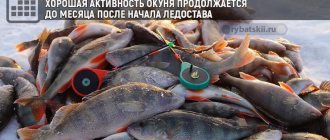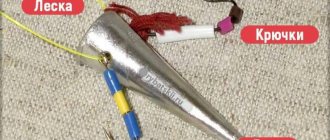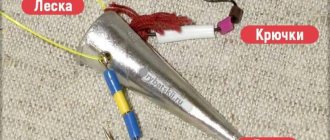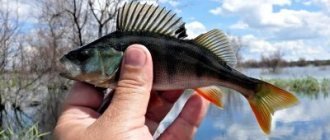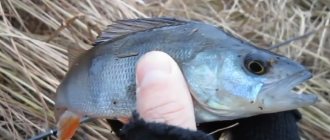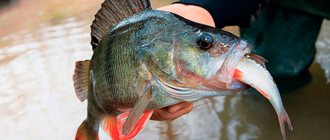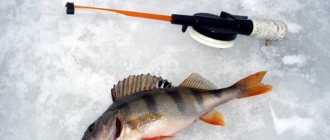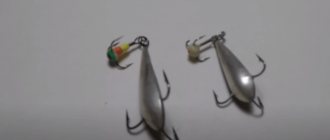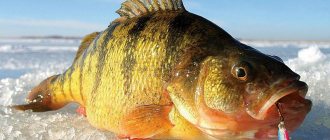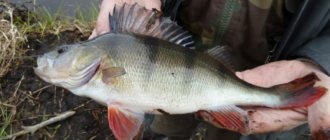Choosing a place to catch perch
When planning a fishing trip, the first thing you need to worry about is choosing a place. Perch is a sedentary fish that does not go far from its usual camps. To determine where fish accumulate, it is necessary to periodically go fishing in late autumn and evaluate the bite. Based on the results obtained, you can easily determine the expected habitat of perch in winter.
After the reservoir has frozen over, conduct another reconnaissance, including identifying the locations and boundaries of underwater obstacles under a thin layer of ice. It makes sense to conduct test fishing in specific places, and then mark the areas most populated by individuals. When setting marks, it is necessary to take into account the thickness of the ice, which can increase until the moment of full-fledged entry into fishing.
At the beginning of winter, the majority of perch concentrate closer to the shore. As soon as the ice begins to grow, the fish go deeper and gather in the places marked during exploration of the first ice. It is advisable to make several marks at once, since there is always a risk of other fishermen appearing or the school leaving the marked area.
On the first ice, perch, even large specimens, feed in shallow water. It can be found near algae, in snags, as well as on various edges and pits.
It is advisable to drill holes at a distance of 3–5 meters from the algae. When positioned too close to such places, there is an increased risk that the bait fish will lead the equipment into the thicket and tangle it. And if you move too far from the mark, it will be difficult to lure the fish to the fishing spot.
As the ice grows, the perch will move towards the middle of the reservoir, looking for the deepest areas. Usually, by December, perches live at maximum depth and stop pecking as actively as they did on the first ice.
Catching perch with fry
Artificial baits are now in fashion and there are some explanations for this: some pride of the fisherman who has outwitted the cautious, and sometimes obstinate, inhabitants of the entire underwater world. But not everyone has the opportunity to get jigs or other artificial baits for fishing. Therefore, traditional baits are used, for example, whitebait (verkhovka or verkhovka), which is unjustifiably forgotten by city fishermen and, on which, the bite is no worse than on a jig or spinner.
It has been repeatedly proven that perch responds well to live bait and is more willing to take small bait. But it’s not so easy to catch the topwater itself, so if you have the opportunity to purchase it, it’s better not to waste time looking for it.
Many fishermen claim that perch go well with this bait on the first ice and for another week and a half, or even two after that. In winter, the fry won’t really surprise him; the perch at this time is quite passive and more often rushes to small jigs.
How to choose fry for perch
Almost any small fish is suitable for ice fishing for perch with fry in winter. However, it is best to use live bait with narrow, elongated bodies. It is also advisable to select the species that is found in a particular body of water. In this case, the perch will become accustomed to the fry and will respond better to potential prey. Fish with a wide body (for example, bream fry) are not suitable, since the perch is extremely reluctant to react to such prey.
Most often used as live bait:
- minnow;
- roach;
- dace;
- small perch, etc.
When choosing bait, special attention must be paid to the time during which the individual remains viable. A minnow strung on a hook lives the longest. It is advisable to select bait 3–8 cm long, since the perch is unlikely to pay attention to smaller specimens.
You can catch the fry using a fishing rod, but this method will require a significant amount of time. It is much more convenient to use a top with small cells. You can make such a design with your own hands without any problems.
Fishing for bait proceeds as follows:
- An ice hole is created in the ice, where bait is poured.
- The top falls into the water.
- After some time, you need to raise the top, along with it, pulling out the live bait that got into the cells.
For convenience, live bait can be prepared in advance for future use. In a barrel of water placed in a cool place, the fry are stored for 1–2 weeks. In this case, it is necessary to periodically add food and also remove fallen fish.
When going fishing, it is better to store live bait in a can. The necessary conditions to support life will be created inside.
When fishing with sprat, a fisherman can simply buy any small fish in the store and use it as bait, whole or in parts. The choice of dead bait makes it necessary to imitate the game yourself, luring predators.
It is important to know how to properly hook live bait so that the fish does not fall asleep too quickly. The more actively it moves under water, the faster the bite will begin.
Some tips for using bait from live or dead fish
Towards the end of autumn, pike perch begins to eat, which will last until the end of November and the onset of the first ice. During this period, it will be better caught on a donk, so you need to choose live bait from its characteristic habitat.
In winter, it is best to carefully study the topography of the bottom of the reservoir before fishing. It will lie in deep places where the water is warmer. If you manage to catch one individual, then you can say with great confidence that there are more representatives of this species nearby, since it hunts in a flock.
The predator's spring feeding period ends around the beginning of June. Spawning occurs in April or May. Everything will depend on weather conditions and how quickly the water heats up.
The bait used is whitebait, which is found in large numbers in this reservoir.
Since the predator often swallows the bait deeply, you should prepare a tool for removing the hook in advance, otherwise problems will arise.
Pike-perch likes to hunt in a school, but large representatives of this species like to stay apart.
How to properly attach a fry
To use bait for a long time, you must be able to properly attach it to gear. In a certain way, a small fish placed on a hook can remain alive for a long time and attract predatory fish.
Live bait is secured in several ways:
- For the lip. This method is most effective when fishing in the current, as well as when using doubles.
- Behind the back. The method is used when using a tee or a large hook. Here it is necessary to hook the bait very carefully, ensuring the safety of the spine. Hooking on the back requires taking into account the fact that the perch does not grab the bait entirely, which means there is no need to rush too much with hooking. When fishing for perch using a jigging rod, it is recommended to wait a little and let the line come off the reel.
- For the gills. The most reliable and safe method that ensures the viability of an individual for a long time. In order for the bait to hold well, you need a fairly large and sharp hook.
An interesting way to catch fry
An interesting way to catch small fish without nets or lifts.
Once I was fishing on a medium-sized river, and I noticed the behavior of pike and perch: they were very active that day. Particularly striking were the throws of the perch, which literally jumped out of the water, dispersing schools of fry. Needless to say, that evening I managed to fish quite well, two good pike and a dozen perch were caught, all on a spinning rod. And my friends were left with a catch; rarely have we managed to get such a bite. The pikes were released into their native elements, and from the perches and minnows that my colleagues caught, we prepared fish soup, the taste of which we enjoyed until late in the evening (about how to properly cook fish soup). And it was while eating delicious fish soup that my friends and I decided to catch perch the next day, but to catch it with fry. That is, not with a spinning rod, not with live bait in the generally accepted sense of this gear, but with a regular float rod for perch (line 0.25 mm, hook somewhere around number 14-17), where the bait would be a whitebait, the size of which should not exceed 1-2 centimeters.
Winter live bait fishing rod for perch fishing
A special live bait fishing rod can be used for catching perch with fry in winter or for luring already dead fish. Even the simplest fishing rod from the store, equipped with a fishing line 0.14-0.25 thick, is quite suitable for winter fishing. The specific diameter of the fishing line is selected based on the planned size of the trophy.
The equipment of a fishing rod for catching perch with fry in winter is quite standard and includes only a fully assembled fishing rod with a securely fastened fishing line. There are also no special requirements for the coil. You can use both inertial and inertial-free models of a suitable configuration.
The sinker and hook are carefully secured to the fishing line, after which a live fry is attached. The finished tackle can be immediately lowered into the hole. This type of fishing requires constant monitoring of gear, since hooking must be done 2-3 seconds after the start of the bite.
Perch gear can have different configurations, depending on specific fishing conditions. The solution described above is perfect for catching perch with live bait from ice at shallow depths and without a current. If there is a current, you will need a heavy sliding sinker to hold the rig in the right place near the bottom of the reservoir.
Live bait winter tackle for perch can be represented by a regular trolling rod. A fishing rod for perch in winter should have a length of up to 30–40 cm; at the end you will need to attach a nod made of a metal spring or plate. It must bend 45 degrees without any problems.
Preparing gear
Tackle for catching perch must be prepared in advance. Well suited as a device for fishing with live bait - a zherlitsa. It is also recommended to use a winter fishing rod for perch, equipped with a jig with an extended hook and a hard metal nod. The equipment of a winter fishing rod in the form of a hard nod and a long hook makes it more convenient to attach live bait and perform the so-called bait game. This tackle is used for catching medium and small perch; in order to catch large perch, it is better to make a special girder for winter fishing. A winter perch, also called a flag, can be made from scrap materials on your own. To do this, you need the following: • A small lath, about the width of a matchbox, and no more than 20 in length • A reel from a winter fishing rod • A not very stiff spring, no more than 10 cm long • A bead up to 20 cm long or a rigid steel wire that fits tightly into the spring. • Standard equipment for any fishing line: line, sinker, tee and leader. It all comes together as follows. A coil is installed on the rail approximately in the middle. A metal spring is mounted at the edge of the rail on either side, then either a bead with a red ribbon at the end or a metal wire is attached to the spring. Thus, it should turn out that the wire or strip can be bent to the coil without using much effort. If everything is correct, then you should next make a special hook on the rail approximately at the level of the reel, through which the fishing line will then be passed and will hold the rail in the position of waiting for a bite. At the last stage, the fishing line is wound onto the reel, and the lead and tee are installed. If everything is assembled correctly, the end result will work according to the following scheme. When biting, the perch captures the prey, while pulling the fishing line, which, jumping off the hook on the rail or wire, releases it. As a result of this, the rod takes a vertical position and signals the happy fisherman about a bite. There are many varieties of winter fishing rods; every fisherman tries to improve or come up with something new. It is important to know the principles that need to be followed when making your own version of the girders. • The bait must signal a bite. • It is advisable that it be visible from afar. • A certain amount of fishing line after biting should be unwound from the girder without any difficulty. • The design of the winter vent should not go into the hole. Reliable tackle is very important in order not to leave fishing without a catch, but another component of successful fishing is the tactics and technique used when fishing.
Current rigging
With proper preparation, you can catch perch in winter with fry even in strong currents. Such conditions even have some advantages, since they allow you to do without live bait. Dead fry or sprat are quite suitable as bait.
The equipment should include a sliding sinker and a stopper that holds the bait at a certain depth. Retractable leashes with hooks work great.
A strong current will allow even dead fish to move as if they were alive. If several gears are installed, then it is necessary to secure them very securely on the ice surface. Otherwise, the perch may drag the fishing rod under the ice.
The fry can be hooked either on one hook or on several. The option with two hooks secured with wire works great. One of them is located in the head of the bait, while the other is in the tail.
Catching perch with sprat
Winter fishing for perch with sprat is extremely popular due to the availability of this bait. In this case, the process is reminiscent of catching pike perch using sprat or burbot, including the use of the same baits, but of a smaller size.
Tulka is the name of a small fish that becomes sexually mature when it reaches a size of about 5 cm. It is found in the Black, Azov and Caspian seas. However, fishermen call any dead fish used as bait as sprat. This approach works great for catching pike perch and also attracts perch well.
If there is a current or when fishing at great depths, heavy jigs will be required. Fishing from the shore involves the use of catchable jigs for perch weighing 1–2 grams with a large hook. The sprat is planted whole or in parts. Almost any dead fry will do. To attract a predator, you need to play with the bait, tugging and pulling the line with some pauses.
Winter fishing for perch with live bait is an extremely exciting activity, which, with the right approach, can provide an excellent catch. You just need to choose the right fishing location, choose bait and attract the attention of predators. Even a perch that is quite sluggish in winter will not mind feasting on the prey provided.
Fishing Features
Along with the undeniable advantages, winter fishing for perch with live bait has a number of disadvantages:
1. Additional fuss with live bait while hooking. At low temperatures this creates additional inconvenience.
2. It is necessary to ensure the storage of live bait before entering the reservoir, during transportation and directly on the reservoir during the fishing process.
3. Fishing in this way significantly reduces mobility when moving is necessary.
A good catch more than compensates for the basic discomfort when catching perch with live bait. When fishing with live fish, you can count on catching a larger specimen. They are more likely to grab minnows than artificial bait. When the deep winter sets in, then catching perch in winter with live bait is most effective.
